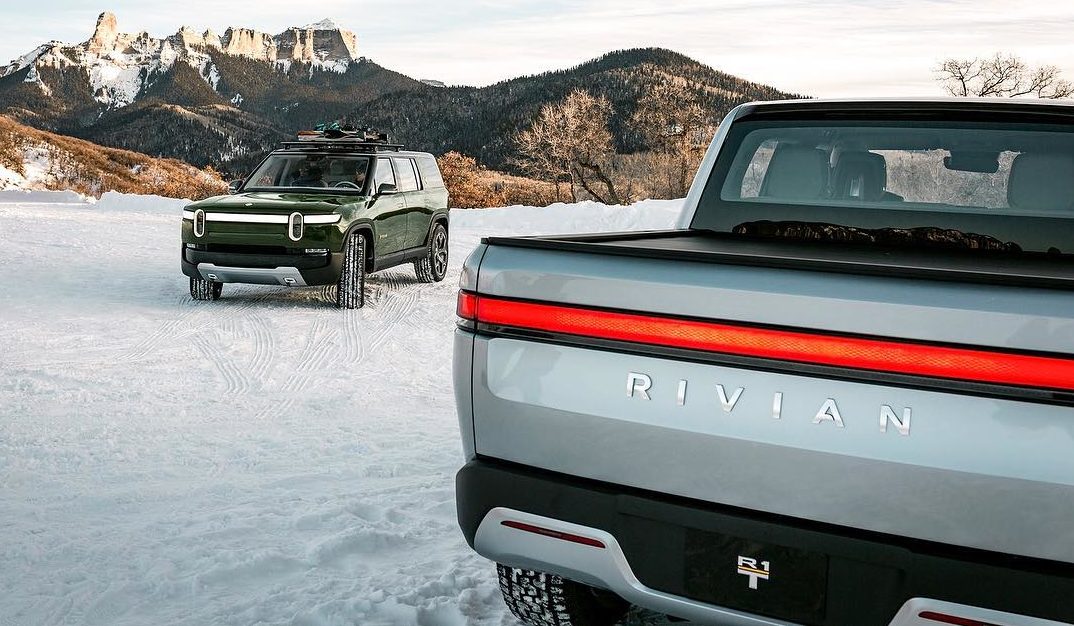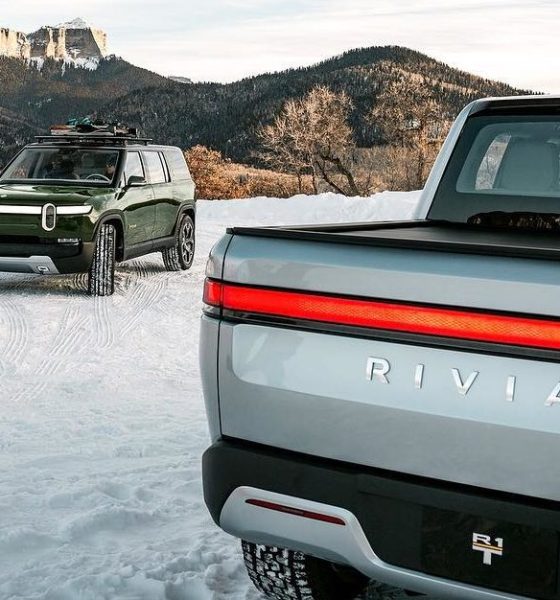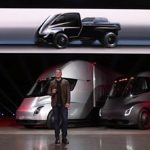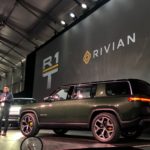With Detroit-based Rivian Automotive stepping into the limelight, the electric car maker has seen itself being compared to Silicon Valley-based Tesla, a first mover in the EV market. Over the following week, Rivian and its CEO, RJ Scaringe, has been dubbed as several things, among them being “Tesla’s worst nightmare.” This is a flawed assumption.
Rivian emerged from the shadows late last year, surprising the auto industry by revealing two production-ready vehicles that feature the best that electric cars can offer — instant power, luxury, and a killer design. With this in mind, it is not surprising that the company is perceived with optimism by Wall Street and potential investors. Morgan Stanley analyst Adam Jonas, for one, noted that Tesla’s dominance in the US EV market could be “unsustainable” as it faces “serious competition” from Rivian, considering the younger company’s “access to talent and capital” and its focus on the “fastest growing segments of pickup trucks & SUVs.”
Yesterday, reports also emerged that high-profile investors such as GM and Amazon are in talks to invest in Rivian. Provided that the reports are accurate, Reuters noted that Rivian’s valuation would rise to between $1 to $2 billion once the deal goes through. That’s incredibly impressive for the electric car maker, and it bodes well for the EV industry in general as it provides much-needed funds for the development of clean transportation. What it does not do is prove that Tesla will run into trouble because of Rivian’s upcoming and seemingly inevitable rise.
- Tesla CEO Elon Musk unveils the Tesla Semi. (Credit: Tesla)
- The Rivian R1T and R1S take center stage at the 2018 LA Autoshow
Tesla CEO Elon Musk and Rivian CEO RJ Scaringe both aim to rid the world of fossil fuels.
While rivalries present a compelling narrative, it is difficult to paint Tesla and Rivian as rivals trying to beat each other without compromising each company’s character. Tesla’s Elon Musk, for one, has always encouraged the development of more electric cars. In a recent tweet late last month, Musk noted that it is “exciting to see all the new electric vehicles coming to market,” referring to a report of other EVs set to debut in the coming years. In a later post, Musk added that Tesla’s true competition is not new electric vehicles, but rather, the “enormous flood of gasoline cars pouring out of the world’s factories every day.”
In his most recent 60 Minutes segment, Musk went so far as to state that “if somebody comes and makes a better electric car than Tesla, and it’s so much better than ours that we can’t sell our cars, and we go bankrupt, I still think that’s a good thing for the world.” It remains unknown if Elon Musk could ultimately put his foot where his mouth is, but considering his statements so far, he definitely appears to be fully supportive of other electric car makers, including Rivian.
Rivian, for its part, has never given an indication that it is going after Tesla. The electric car maker has established since the reveal of its first truck that it is dedicating itself to the production of luxury adventure vehicles (at least for now) with zero compromises. Rivian CEO RJ Scaringe has also been pretty open about his opinion of Tesla. During a fireside chat at the Automotive News World Congress last month, Scaringe credited Tesla for disproving “untruths” about electric vehicles. Simply put, everything that Rivian has done so far indicates that it acknowledges Tesla, and it is fully onboard with the company’s mission of accelerating the advent of sustainable energy.
Mainstream media loves pitting companies, products, and people against each other — Apple’s iOS and Google’s Android, Sony’s PlayStation and Microsoft’s Xbox, Celebrity A and Celebrity B, the list is endless. In the case of Tesla and Rivian and their CEOs, this idea does not seem to line up very well. In their respective segments alone, the companies should not be compared, considering that Tesla is pursuing the mainstream market with the Model 3 and the upcoming Model Y, while Rivian is focusing on the luxury adventure sphere with the R1T and R1S. Until Tesla releases its own pickup truck, then the two electric car makers are best seen as allies in the transition away from fossil fuels — not rivals attempting to overpower each other.

News
Tesla (TSLA) receives “Buy” rating and $551 PT from Canaccord Genuity
He also maintained a “Buy” rating for TSLA stock over the company’s improving long-term outlook, which is driven by autonomy and robotics.

Canaccord Genuity analyst George Gianarikas raised his Tesla (NASDAQ:TSLA) price target from $482 to $551. He also maintained a “Buy” rating for TSLA stock over the company’s improving long-term outlook, which is driven by autonomy and robotics.
The analyst’s updated note
Gianarikas lowered his 4Q25 delivery estimates but pointed to several positive factors in the Tesla story. He noted that EV adoption in emerging markets is gaining pace, and progress in FSD and the Robotaxi rollout in 2026 represent major upside drivers. Further progress in the Optimus program next year could also add more momentum for the electric vehicle maker.
“Overall, yes, 4Q25 delivery expectations are being revised lower. However, the reset in the US EV market is laying the groundwork for a more durable and attractive long-term demand environment.
“At the same time, EV penetration in emerging markets is accelerating, reinforcing Tesla’s potential multi‑year growth runway beyond the US. Global progress in FSD and the anticipated rollout of a larger robotaxi fleet in 2026 are increasingly important components of the Tesla equity story and could provide sentiment tailwinds,” the analyst wrote.
Tesla’s busy 2026
The upcoming year would be a busy one for Tesla, considering the company’s plans and targets. The autonomous two-seat Cybercab has been confirmed to start production sometime in Q2 2026, as per Elon Musk during the 2025 Annual Shareholder Meeting.
Apart from this, Tesla is also expected to unveil the next-generation Roadster on April 1, 2026. Tesla is also expected to start high-volume production of the Tesla Semi in Nevada next year.
Apart from vehicle launches, Tesla has expressed its intentions to significantly ramp the rollout of FSD to several regions worldwide, such as Europe. Plans are also underway to launch more Robotaxi networks in several more key areas across the United States.
News
Waymo sues Santa Monica over order to halt overnight charging sessions
In its complaint, Waymo argued that its self-driving cars’ operations do not constitute a public nuisance, and compliance with the city’s order would cause the company irreparable harm.

Waymo has filed a lawsuit against the City of Santa Monica in Los Angeles County Superior Court, seeking to block an order that requires the company to cease overnight charging at two facilities.
In its complaint, Waymo argued that its self-driving cars’ operations do not constitute a public nuisance, and compliance with the city’s order would cause the company irreparable harm.
Nuisance claims
As noted in a report from the Los Angeles Times, Waymo’s two charging sites at Euclid Street and Broadway have operated for about a year, supporting the company’s growing fleet with round-the-clock activity. Unfortunately, this has also resulted in residents in the area reportedly being unable to sleep due to incessant beeping from self-driving taxis that are moving in and out of the charging stations around the clock.
Frustrated residents have protested against the Waymos by blocking the vehicles’ paths, placing cones, and “stacking” cars to create backups. This has also resulted in multiple calls to the police.
Last month, the city issued an order to Waymo and its charging partner, Voltera, to cease overnight operations at the charging locations, stating that the self-driving vehicles’ activities at night were a public nuisance. A December 15 meeting yielded no agreement on mitigations like software rerouting. Waymo proposed changes, but the city reportedly insisted that nothing would satisfy the irate residents.
“We are disappointed that the City has chosen an adversarial path over a collaborative one. The City’s position has been to insist that no actions taken or proposed by Waymo would satisfy the complaining neighbors and therefore must be deemed insufficient,” a Waymo spokesperson stated.
Waymo pushes back
In its legal complaint, Waymo stated that its “activities at the Broadway Facilities do not constitute a public nuisance.” The company also noted that it “faces imminent and irreparable harm to its operations, employees, and customers” from the city’s order. The suit also stated that the city was fully aware that the Voltera charging sites would be operating around the clock to support Waymo’s self-driving taxis.
The company highlighted over one million trips in Santa Monica since launch, with more than 50,000 rides starting or ending there in November alone. Waymo also criticized the city for adopting a contentious strategy against businesses.
“The City of Santa Monica’s recent actions are inconsistent with its stated goal of attracting investment. At a time when the City faces a serious fiscal crisis, officials are choosing to obstruct properly permitted investment rather than fostering a ‘ready for business’ environment,” Waymo stated.
News
Tesla FSD v14.2.2 is getting rave reviews from drivers
So far, early testers have reported buttery-smooth drives with confident performance, even at night or on twisty roads.

Tesla Full Self-Driving (Supervised) v14.2.2 is receiving positive reviews from owners, with several drivers praising the build’s lack of hesitation during lane changes and its smoother decision-making, among others.
The update, which started rolling out on Monday, also adds features like dynamic arrival pin adjustment. So far, early testers have reported buttery-smooth drives with confident performance, even at night or on twisty roads.
Owners highlight major improvements
Longtime Tesla owner and FSD user @BLKMDL3 shared a detailed 10-hour impression of FSD v14.2.2, noting that the system exhibited “zero lane change hesitation” and “extremely refined” lane choices. He praised Mad Max mode’s performance, stellar parking in locations including ticket dispensers, and impressive canyon runs even in dark conditions.
Fellow FSD user Dan Burkland reported an hour of FSD v14.2.2’s nighttime driving with “zero hesitations” and “buttery smooth” confidence reminiscent of Robotaxi rides in areas such as Austin, Texas. Veteran FSD user Whole Mars Catalog also demonstrated voice navigation via Grok, while Tesla owner Devin Olsen completed a nearly two-hour drive with FSD v14.2.2 in heavy traffic and rain with strong performance.
Closer to unsupervised
FSD has been receiving rave reviews, even from Tesla’s competitors. Xpeng CEO He Xiaopeng, for one, offered fresh praise for FSD v14.2 after visiting Silicon Valley. Following extended test drives of Tesla vehicles running the latest FSD software, He stated that the system has made major strides, reinforcing his view that Tesla’s approach to autonomy is indeed the proper path towards autonomy.
According to He, Tesla’s FSD has evolved from a smooth Level 2 advanced driver assistance system into what he described as a “near-Level 4” experience in terms of capabilities. While acknowledging that areas of improvement are still present, the Xpeng CEO stated that FSD’s current iteration significantly surpasses last year’s capabilities. He also reiterated his belief that Tesla’s strategy of using the same autonomous software and hardware architecture across private vehicles and robotaxis is the right long-term approach, as it would allow users to bypass intermediate autonomy stages and move closer to Level 4 functionality.












